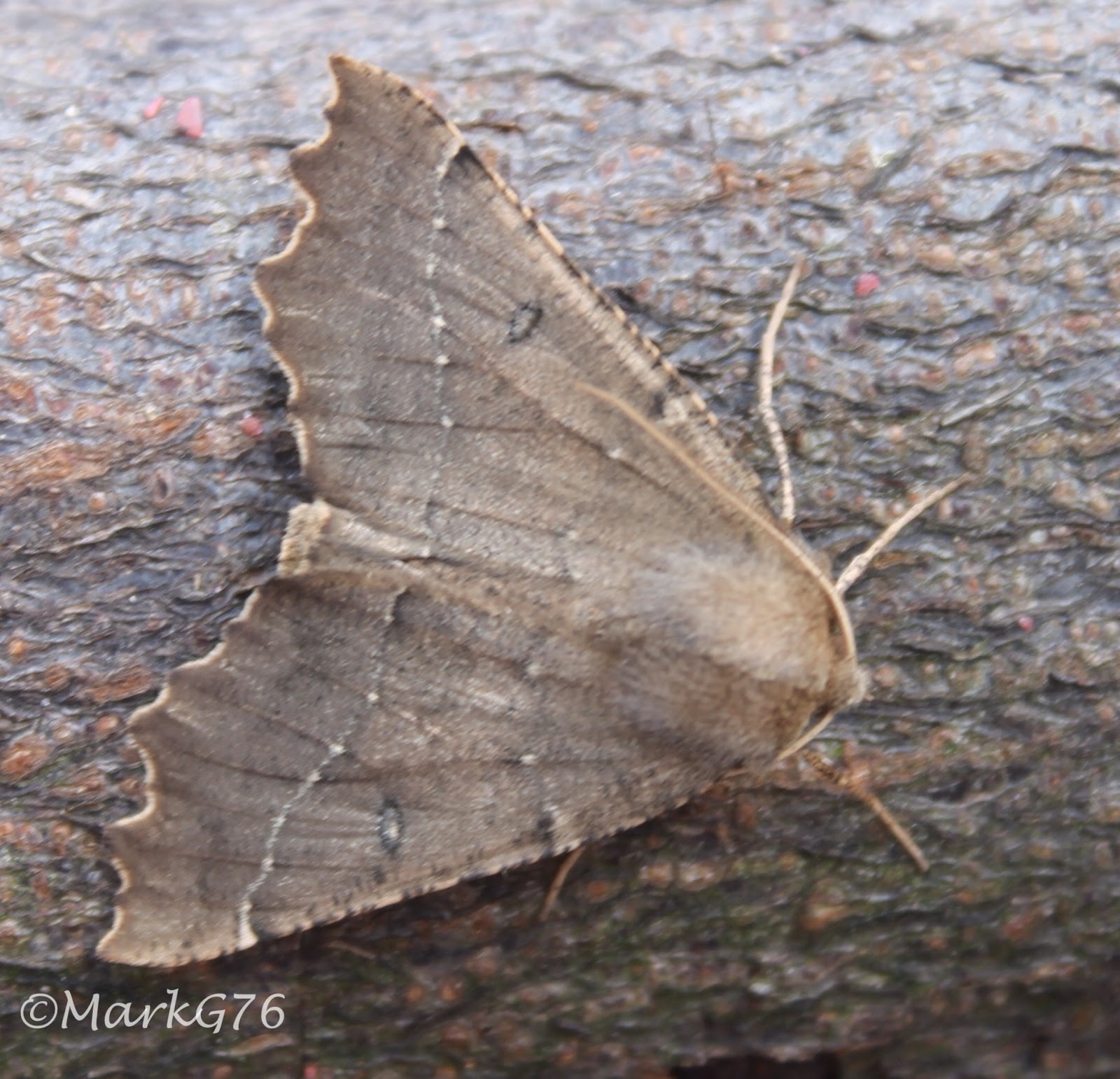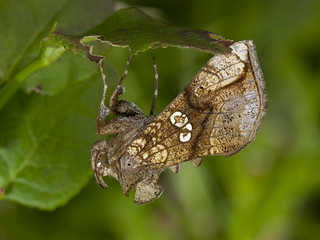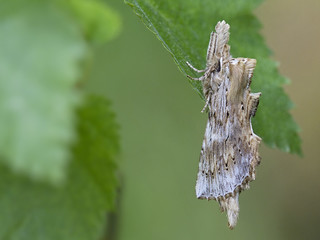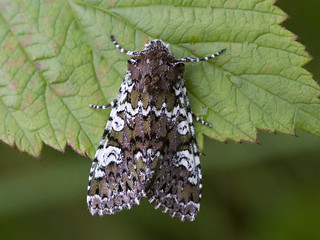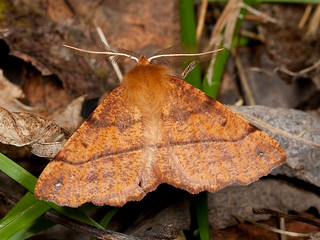Last night was better moth-wise here in South Bucks. I was especially pleased to see that one of them was a lifer for me; I'd heard a lot of reports of them being caught around the place, but not seen one until now. Although due to circumstances beyond my control, I failed to get a photo :(
Still, three new ones for the garden challenge list!
Common Pug - 4
Yellow-barred Brindle - 1
Chocolate Tip - 1 (Lifer!)
Scalloped Hazel - 1
Grey Pine Carpet - 1 (first of the year)
Green Carpet - 1
Orange Footman - 1 (new for garden year list)
Friday 31 May 2013
50 - 'A Mini Milestone'
After a slow start things seem to be picking up and despite some less than regular trapping due to being away surveying newts I have managed to pass 50 species of moth and butterflies for the garden. As of today (31/05) my total stands at 51 of which 7 are butterflies and 44 species of moth.
Must say thanks to the Twitter #teammoth for all their help and I'm hoping to pass the 100 species at some point this summer (if we have one).
Highlights this year have been two species of Hawk-moth (Poplar and Lime), Spectacled, Peppered Moth, The Miller, Scalloped Hazel, Early Thorn and Pine Beauty.
Here's a selection of moths caught - all of which you will have seen already if you follow me on Twitter (@MarkG76).
Blogger is being a pain again - hence random picture sizes and no captions!
Must say thanks to the Twitter #teammoth for all their help and I'm hoping to pass the 100 species at some point this summer (if we have one).
Highlights this year have been two species of Hawk-moth (Poplar and Lime), Spectacled, Peppered Moth, The Miller, Scalloped Hazel, Early Thorn and Pine Beauty.
Here's a selection of moths caught - all of which you will have seen already if you follow me on Twitter (@MarkG76).
 |
| Pine Beauty |
Blogger is being a pain again - hence random picture sizes and no captions!
Puggy Mc Pug Pug
A couple of weeks since my last post and not a vast amount to report but here goes...
34. Common Nettle Tap
35. Angle Shades
36. Rustic Shoulder-knot
37. Common Swift
38. Flame Shoulder
39. Purple Bar
I was particularly pleased with the Purple Bar as its a new moth to me and a tidy wee beast to boot. In addition to the above I had a couple of Pugs. They wrecked my brain. Would those with good pug knowledge please pass judgement on my I.D. effort below - a new pug could herald my 40th moth for the garden this year!
Just looked at the Latest Scores page - blimey! A couple have already cracked the one ton mark! Well done to Lionel and Andy, that is some furious mothing.
Till next time - happy moth'ing!
34. Common Nettle Tap
35. Angle Shades
36. Rustic Shoulder-knot
37. Common Swift
38. Flame Shoulder
39. Purple Bar
I was particularly pleased with the Purple Bar as its a new moth to me and a tidy wee beast to boot. In addition to the above I had a couple of Pugs. They wrecked my brain. Would those with good pug knowledge please pass judgement on my I.D. effort below - a new pug could herald my 40th moth for the garden this year!
 |
| Angle Shades |
 |
| Rustic Shoulder-knot |
 |
| Spectacle |
 |
| Spectacle... again! |
 |
| Common Swift |
 |
| Purple Bar |
 |
| Puggy Mc Pug Pug? |
 |
| Worn Double-striped Pug? Grey Pug? |
Till next time - happy moth'ing!
Labels:
#teammoth,
Garden Moth Scheme,
Garden Moths,
Moth,
mothtrap,
Suffolk,
VC26
Thursday 30 May 2013
Still Slow
In fact, last night I had better than I'd expected given that it was raining pretty much all of yesterday and most of the night.
I tend to leave my trap out all the time, switched on and off with a timer, so I do run on wet nights. Sometimes it works...but I'm clearly not having a good year generally :(
1 x LBAM
1 x Emmelina mondactyla
1 x Brimstone
1 x Waved Umber
1 x Scalloped Hazel (new for this year's garden list)
I tend to leave my trap out all the time, switched on and off with a timer, so I do run on wet nights. Sometimes it works...but I'm clearly not having a good year generally :(
1 x LBAM
1 x Emmelina mondactyla
1 x Brimstone
1 x Waved Umber
1 x Scalloped Hazel (new for this year's garden list)
Wednesday 29 May 2013
Numbers picking up but slowly, slowly...
Like others, we're finding that numbers are increasing (some nights - I didn't bother last night, as it was cold and generally unpromising) but still seem low for the time of year: it says something that a haul of six Green Carpets on the 26th was the biggest number of individuals of any one species this year so far. However, the 26th and 27th were both productive, with Flame Shoulders starting to come to the fore: on the 27th, several species new this year, or new to the garden altogether were among the catch - Flame Carpet, Freyer's Pug, Pebble Hook-tip and a pretty little micro, Cochylis atricapitana. Perhaps the most spectacular was the Poplar Hawkmoth, clinging to one of our eggboxes, and practically too big to fit in a viewing container.
 |
| Cochylis atricapitana, 27th May |
 |
| Flame Carpet, 27th May |
 |
| Poplar Hawkmoth, 27th May |
I've been finding it increasingly hard to avoid going and checking around the trap at intervals over the evening, and that's been proving a good way of finding individuals which otherwise might not actually go in the trap - a very handsome Coronet on the 26th was a good example. Anyway, that brings us to a total of 68 species for the year: 62 moths, plus six butterflies.
Well, it's nearly the end of May, and the moths are coming at a trickle rather than a flood, but still a surprising diversity in the garden considering the relatively mundane surroundings. I seem to have recorded single specimens of quite a few species, including the latest - coxcomb prominent. Besides the moth trap, I have also been looking for teeny weeny micros coming to flowers during the day, and have pinned down the awesomely minute Glyphipteryx simpliciella, the Cocksfoot moth. Still waiting for the first hawk, which should come any day now. I have previously recorded privet, elephant and poplar hawks - my ambition is to photograph all three together.
Also looking out for the first migrant moth; there have been a couple of nights recently with misty conditions, good for migrant birds, and I am guessing there might be the odd migrant moth floating around as well. Here's hoping. So, the garden moth challenge list stands at 69, with a few other species recorded in my 1km square for the sister challenge, 1000 for 1km square. An exciting Sunday yielded wall brown (rare inland in Norfolk now) and speckled wood butterflies. One of those in the garden would do.
Planning to have a moth social or two, including a moth-e-Q and a moth garden party. If the weather warms up. Fingers crossed!
Also looking out for the first migrant moth; there have been a couple of nights recently with misty conditions, good for migrant birds, and I am guessing there might be the odd migrant moth floating around as well. Here's hoping. So, the garden moth challenge list stands at 69, with a few other species recorded in my 1km square for the sister challenge, 1000 for 1km square. An exciting Sunday yielded wall brown (rare inland in Norfolk now) and speckled wood butterflies. One of those in the garden would do.
Planning to have a moth social or two, including a moth-e-Q and a moth garden party. If the weather warms up. Fingers crossed!
Finally, a decent haul!
The numbers are starting to pick
up at last and we had a great catch in our trap at The Lodge last week. The
best crowd-pleasers were two lovely Lime Hawk-moths. The full list is as
follows:
Pale Prominent 1
Pale Tussock 1
Nut-tree Tussock 4
Peppered Moth 1
Pine Beauty 2
Lesser Swallow Prominent 1
Incurvaria masculella 1
Red Twin-spot Carpet 1
Common Carpet 1
Spruce Carpet 1
Lime Hawk-moth 2
Knotgrass 1
The Miller 1
Flame Shoulder 1
Brindled Pug 1
Lime Hawk-moth
Peppered Moth
The Miller
Pale Tussock
The moth of the month has to be
the understated Brindled Pug. Each trap seems to yield at least one of these
beasts. Not the most attractive things, but they have been causing much
amusement for us when every single pug we seem to catch is one of them – “oh,
and another Brindled Pug for the list”! When in doubt, call it a Brindled... We
have also had a Green Pug and are keenly awaiting the arrival of some more of
the non-brindled kind of pugs. Here’s hoping!
Other highlights this month have
been Maiden’s Blush, Coxcomb Prominent, Frosted Green, Purple Bar and Least
Black Arches. We’re still a bit low on the butterfly count (must try harder!)
with 5 species so far, but the moth count is doing better on 49, which takes us
just above the fifty mark at 54 species.
Good enough to eat
It’s still fairly slow here in Cambridge, but the trap has
been turning up some species that I’ve never seen before like this
Chocolate-tip:
Some further new species to me have been the Bee Moth, Shuttle-shaped
Dart, Yellow-barred Brindle and the beautiful little micro Argyrotaenia ljungiana. Other highlights have included Early Grey
and Clouded Drab (yes, I know what you’re thinking – not the most exciting
looking or named moth, but I love these beasts for some reason!).
Argyrotaenia ljungiana
Yellow-barred Brindle
There have been a lot of butterflies around in the garden as
well. A Speckled Wood arrived a few weeks ago and continues to challenge any
butterfly, bird, or indeed anything that comes into its territory. I've been pleased to see that the Holly Blues
have been egg laying on the Ivy trailing over our fence and some Small Whites
have also become regular visitors. Last weekend an Orange-tip and a Brimstone
fluttered across the garden while I was enjoying the sunshine and these were
later joined by a Brimstone moth, which posed nicely for a photo.
The total so far is 27 species (20 moths + 7 butterflies).
Tuesday 28 May 2013
Howick Northumberland
 |
| White spotted Pug |
A mild 9 degrees with cloud improved the
variety...a nice White spotted Pug the highlight.
Taxa
0464 Diamond-back Moth (Plutella xylostella) 3
0648 White-shouldered House Moth (Endrosis sarcitrella) 1
1722 Flame Carpet (Xanthorhoe designata) 1 NFY
1728 Garden Carpet (Xanthorhoe fluctuata) 1 NFY
1738 Common Carpet (Epirrhoe alternata) 1 NFY
1750 Water Carpet (Lampropteryx suffumata) 1
1834 Common Pug (Eupithecia vulgata) 1 NFY
1835 White-spotted Pug (Eupithecia tripunctaria) 1 NFY
1862 Double-striped Pug (Gymnoscelis rufifasciata) 1
2060 White Ermine (Spilosoma lubricipeda) 1
2123 Small Square-spot (Diarsia rubi) 1 NFY
2186 Powdered Quaker (Orthosia gracilis) 2
2188 Clouded Drab (Orthosia incerta) 1
2190 Hebrew Character (Orthosia gothica) 1
2425 Nut-tree Tussock (Colocasia coryli) 1
18 moths of 15 sp.
Taxa
0464 Diamond-back Moth (Plutella xylostella) 3
0648 White-shouldered House Moth (Endrosis sarcitrella) 1
1722 Flame Carpet (Xanthorhoe designata) 1 NFY
1728 Garden Carpet (Xanthorhoe fluctuata) 1 NFY
1738 Common Carpet (Epirrhoe alternata) 1 NFY
1750 Water Carpet (Lampropteryx suffumata) 1
1834 Common Pug (Eupithecia vulgata) 1 NFY
1835 White-spotted Pug (Eupithecia tripunctaria) 1 NFY
1862 Double-striped Pug (Gymnoscelis rufifasciata) 1
2060 White Ermine (Spilosoma lubricipeda) 1
2123 Small Square-spot (Diarsia rubi) 1 NFY
2186 Powdered Quaker (Orthosia gracilis) 2
2188 Clouded Drab (Orthosia incerta) 1
2190 Hebrew Character (Orthosia gothica) 1
2425 Nut-tree Tussock (Colocasia coryli) 1
18 moths of 15 sp.
Cheers Stewart
Struggling in Oxford
It's been a real struggle here in Oxford for the last week: I've been running the trap whenever possible but with little to show for it. I've managed to add a few year ticks in dribs and drabs though it's been hard work. I've added a few micros, including Horse Chestnut Leaf Miner, a dark form of the Ash Bud Moth and a day-flying Pyrausta Aurata. I finally managed to get a Green-veined White butterfly in the garden so I've now managed to get all the common whites. The most exciting find was this morning when I found my first ever Poplar Hawk Moth for the garden lurking at the bottom of the trap.
Dark form of Ash Bud Moth, found on my car
Dark or Grey Dagger
Poplar Hawk Moth - a great looking beast
I can't wait for some decent weather so that I can get a more than a handful of moths in the trap each morning.
Latest score 41 moths & 7 butterflies = 48
Monday 27 May 2013
In my Lincolnshire Wolds
Garden
Thought I would give a try last night, as I haven't trapped since the 18th May. Still very low night temperatures, but did manage 19 moths of 12 species and pleased to get 7 new for year.
Catch as follows:-
Grey Dagger agg. NFY 1
Bright-line Brown-eye NFY 1
Pebble Prominent 2
Waved Umber 2
Nutmeg NFY 1
Garden Carpet NFY 2
Poplar Hawk-moth NFY 1
Rustic Shoulder-knot 3
Rivulet NFY 2
Muslin 1
Hebrew Character 1
Buff Ermine NFY 2
Sunday 26 May 2013
What's in a name?
Tonight looks quite promising, but last night was fairly poor. However, it did bring two new species for the year: Bright-line Brown-eye, and a small flock of Swallow Prominents - two of which, in fact, turned out to be Lesser Swallow Prominents. Photo hopefully showing the difference (assuming I've not committed a terrible ID error) below.
 |
| Swallow Prominent and Lesser Swallow Prominent, 25th May |
It's worth saying, one of the things I most enjoy (as a bit of a linguist in my professional life) about mothing is the species' common names, many of which seem to have been invented just for the fun of it. For instance, I love the fact that as well as Bright-line Brown-eye, there's a species called Brown-line Bright-eye. And any group of creatures that includes Maiden's Blush and Blood-vein, or Confused and Uncertain, has to be worth attention (I'd love to know whether any other languages have such a rich range of moth names - I suspect not: I certainly don't know of such a tradition in French).
Howick, Northumberland
 |
| Nettle Tap flying around nettles in our garden. |
 |
| Diamond backed Moth my first migrant. |
 |
| Spectacle. |
35 species.
Please check out my blog here to see my holiday mothing from Suffolk...
Cheers Stewart.
Wednesday 22 May 2013
Quality, but not much quantity
Although the next few nights' forecast looks pretty grim (cold, clear), and last night (21st May) wasn't that productive, the 20th produced a nice variety - 19 species easily the biggest range of the year so far, but no more than two of any species present. Still, seven of the species were new for the year, and five of those new to the garden altogether, so nothing to complain about. We thought Iron Prominent, Pale Tussock and White Ermine rather spectacular, and I enjoyed the ID challenge of Rustic Shoulder-Knot, Red Twin-spot Carpet and Agonpterix arenella. However, we've also had our first aggregate of the year, in the form of a Grey-or-Dark-Dagger - however, I believe they count towards the Challenge, so happy to claim it!
.JPG) |
| Iron Prominent, 20th May |
.JPG) |
| Pale Tussock (male), 20th May |
 |
| White Ermine, 20th May |
.JPG) |
| Rustic Shoulder-knot, 20th May |
It would be nice if the weather could stay pleasant for more than two days at a time, but it's nice to see such a variety of moths around anyway.
Nothing too exciting...
Another small catch last night, but it did include one more species for the challenge list, in the form of a slightly worn Yellow-barred Brindle.
I also got very excited about a pug I found during the course of the afternoon on the fence, but after consulting the literature, I've come to the conclusion in was the melanistic form of Common Pug, so although a new form for me, not a new species.
I also got very excited about a pug I found during the course of the afternoon on the fence, but after consulting the literature, I've come to the conclusion in was the melanistic form of Common Pug, so although a new form for me, not a new species.
Tuesday 21 May 2013
Whetstone Leics. Update
Managed to add a few more over the last couple of nights, though the total catches are still down on what I'd normally expect for mid-May. Nothing new for the garden or exciting in the latest additions, with this Lime Hawk definitely the best of the bunch .....
| Taxon | Vernacular | Date Added | |
| 71 | Menophra abruptaria | Waved Umber | 20/05/2013 |
| 70 | Mimas tiliae | Lime Hawk-moth | 20/05/2013 |
| 69 | Eupithecia pulchellata | Foxglove Pug | 20/05/2013 |
| 68 | Eupithecia exiguata | Mottled Pug | 20/05/2013 |
| 67 | Syndemis musculana | 20/05/2013 | |
| 66 | Colostygia pectinataria | Green Carpet | 20/05/2013 |
| 65 | Mompha subbistrigella | 19/05/2013 | |
| 64 | Epiphyas postvittana | Light Brown Apple Moth | 19/05/2013 |
| 63 | Eupithecia vulgata | Common Pug | 19/05/2013 |
A bit better in Stondon, Beds
Melissa and I ran the garden trap Monday and Tuesday nights and added a few more to the year list. Best of the bunch macro wise were Pale & Pebble Prominents, Least Black Arches, Rustic Shoulder-knot (first and second of many!) & Brimstone. Chinese Character was added on 17th.
Very few micros still here but Syndemis musculana in the trap this am was only the second for our garden in nearly 10 years of trapping. The total stands at 34 species for the year.
Walking round the field at the end of our road and netting micros early Sunday evening turned up Anthophila fabriciana (Nettle-tap), Caloptilia semifascia (first time I've seen the adult as usually recorded by leafmine), unid as yet Monopis spp (prob laevigella) & Mompha epilobiella (identical place, day and month to 2 netter here in 2010!). Of course none of these micros count for the GMS.
Cheers
Andy B - @vc30moths
Very few micros still here but Syndemis musculana in the trap this am was only the second for our garden in nearly 10 years of trapping. The total stands at 34 species for the year.
Walking round the field at the end of our road and netting micros early Sunday evening turned up Anthophila fabriciana (Nettle-tap), Caloptilia semifascia (first time I've seen the adult as usually recorded by leafmine), unid as yet Monopis spp (prob laevigella) & Mompha epilobiella (identical place, day and month to 2 netter here in 2010!). Of course none of these micros count for the GMS.
Cheers
Andy B - @vc30moths
A slow start in western Norway
Hi! I live in Bergen, western Norway and I’ve been trapping moths since the summer of 2007. I am, was and will always be a birder, but the fantastic diversity of moths through the spring, summer and autumn has made them my main “targets” from April to September. In June and July 2007 I created the first report system for moths in Norway. The report system, lepidoptera.no, revealed lots of gaps in the knowledge of moth distribution in Norway. Most traditional entomologists have worked in the southeastern part of Norway, overlooking presumed poor lepidoptera areas in western, middle and northern Norway. This made me visit interesting sites that are rarely or never visited by moth collectors, with nice results.
Anyway, the most visited site in my notebook is of course my own garden near the centre of Norway’s second largest city, Bergen. My flat is situated in the Bergen valley, squeezed in between mount Ulriken (643 masl) and Løvstakken (477 masl). My garden is at the foot (meaning about 100 masl) of mount Løvstakken, bordering to the woods (mainly introduced Sitka, but also Maple, Rowan, Birch, different Salix species and a few Pines nearby. I think the annual potential of my garden is about 300 species with one active trap through the season. However, since mid 2007 I have identified and documented about 400 species. About 20 of these have been new for the county of Hordaland.
Bergen has the mildest winters in Norway, and I usually start trapping in late February. This spring has been incredibly late due to the temperatures and heavy snowfalls until early May. I reckon I have lost about 10-15 species already, because conditions for trapping has not been there. Traditional and common early spring moths such as March Moth, Lead-coloured Drab. Red Chestnut, Pale Brindled Beauty and Brindled Beauty have been totally absent!
A few days ago things finally became rather normal in the trap. When writing this my list of species in the Garden Moth Challenge is 38 (including two aggregate "species": Eriocrania semipurpurella/sangii and Caloptilia betulicola/elongella). Today, 21 May 2013, I actually got a new species for the garden; Dawn Flat-body. Not an everyday happening.
Good luck to everybody, and thanks to Tristan for the initiative and administration! I'll end this intro with some previous shots of my garden moths.
Anyway, the most visited site in my notebook is of course my own garden near the centre of Norway’s second largest city, Bergen. My flat is situated in the Bergen valley, squeezed in between mount Ulriken (643 masl) and Løvstakken (477 masl). My garden is at the foot (meaning about 100 masl) of mount Løvstakken, bordering to the woods (mainly introduced Sitka, but also Maple, Rowan, Birch, different Salix species and a few Pines nearby. I think the annual potential of my garden is about 300 species with one active trap through the season. However, since mid 2007 I have identified and documented about 400 species. About 20 of these have been new for the county of Hordaland.
 |
| The red pointer is on my house. Click on the picture to see the online Googlemap. |
Bergen has the mildest winters in Norway, and I usually start trapping in late February. This spring has been incredibly late due to the temperatures and heavy snowfalls until early May. I reckon I have lost about 10-15 species already, because conditions for trapping has not been there. Traditional and common early spring moths such as March Moth, Lead-coloured Drab. Red Chestnut, Pale Brindled Beauty and Brindled Beauty have been totally absent!
A few days ago things finally became rather normal in the trap. When writing this my list of species in the Garden Moth Challenge is 38 (including two aggregate "species": Eriocrania semipurpurella/sangii and Caloptilia betulicola/elongella). Today, 21 May 2013, I actually got a new species for the garden; Dawn Flat-body. Not an everyday happening.
Good luck to everybody, and thanks to Tristan for the initiative and administration! I'll end this intro with some previous shots of my garden moths.
|
|
||||
|
|
||||
|
|
Subscribe to:
Posts (Atom)





